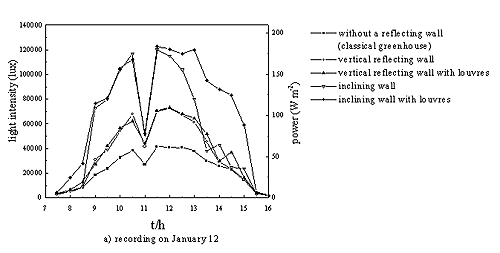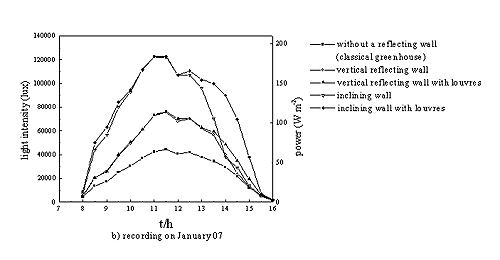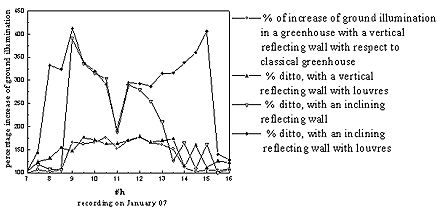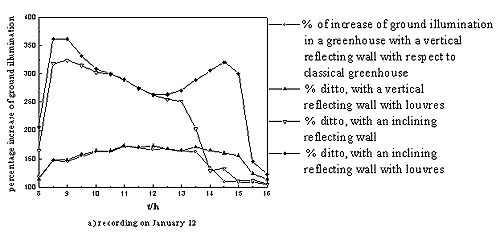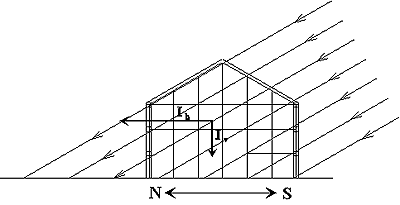
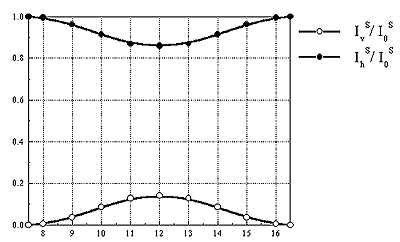
Fig. 1. Relative horizontal and vertical component of solar radiation
on December 21 for 440 N L.
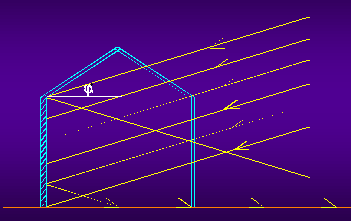
Institute for Architecture and Urban Planning of Serbia
Bulevar revoluvije 73/II, 11000 Beograd, Yugoslavia
e-mail: ljpucar@ptt.yu
Greenhouses represent a common way of protecting plants in cold climate conditions and of growing flowers and vegetables for early supply of markets. An important factor of successful operation of greenhouses, both from the point of view of plant physiology and energy balance, is the intensity (power) of ground insolation. Yet, in winter months and at high geographic latitudes, the sun is very low even in the apex and most of the sunlight goes through the back wall of a greenhouse. Fig.1 shows the participation of the horizontal and vertical components of sunbeams in the shortest winter day (December 21) at 44° NL, when the sun at the apex does not go beyond 22° of elevation above the horizon.


Fig. 1. Relative horizontal and vertical component of solar radiation
on December 21 for 440 N L.

In the present communication an idea was elaborated of using total sunlight entering the greenhouse by reflecting the sunbeams from the back wall of a greenhouse onto the ground. Four types of greenhouses were envisaged shown schematically in Figs.2, 3, 4 and 5. Fig. 2 shows a greenhouse with a fixed vertical wall clad with reflecting material (e.g. aluminium foil), Fig.3 shows a greenhouse with a fixed reflecting wall built at an angle, a , with respect to the ground.
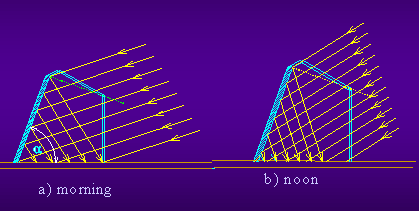
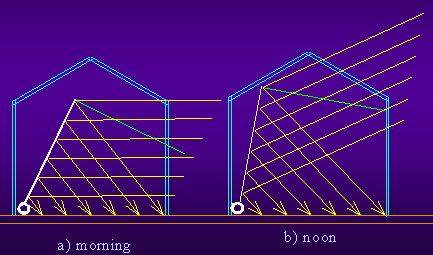
Fig. 4 shows a greenhouse with a separate reflecting wall placed on a horizontal axle, whose inclination can be changed for optimal response (reflection) to the changing elevation angle, j , of the sun from sunrise to sunset and Fig. 5 shows a greenhouse with reflecting wall similar to that under (Fig.4) but with the wall divided into vertical louvres which could be rotated to fallow the changing azimuth angle of the sun.

A quantitative theory was developed which permitted calculating ground illumination intensities at different geographic latitudes and in different days from the shortest winter day to the equinox. The result could be compared with a classical greenhouse (receiveing direct ground radiation only) as to estimate the degree of enhancement that could be achieved using this principle.
The specific sunbeam intensity (the power of solar radiation on m2
of a plane normal to beam in Wm-2 ) is needed for calculation.
This was assessed from meteorological data for the example of the State
of Maine (USA) at 44° NL. For a clear sky
an average value of 164 Wm-2 is obtained. In Fig. 6 the values
of ground irradiation are shown, calculated for cases without the reflecting
wall, with a fixed reflecting wall inclined at 60°
and a reflecting wall with adjustable inclination. The overall energy gain
is also shown. The corresponding coefficients are shown in Fig. 7. Large
enhancements are achieved especially in morning and evening hours when
the sun is low.

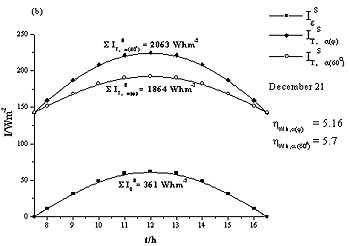
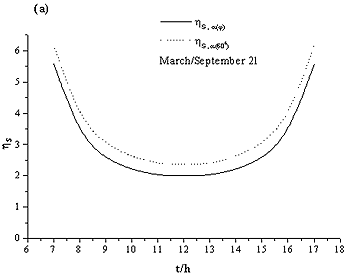
It is interesting to note that the enhancement is apparently smaller with the wall with adjustable inclination than with that fixed at 60° . This is an artefact due to the fact that in the former case the insolation is even over the entire floor, while in the latter case, at the apex, only 30% of the floor close to the wall is under increased illumination. The rest of the floor is illuminated like classical greenhouse. Hence, the overall enhancement and energy gain over the entire greenhouse floor is significantly larger in the former than in the latter case.
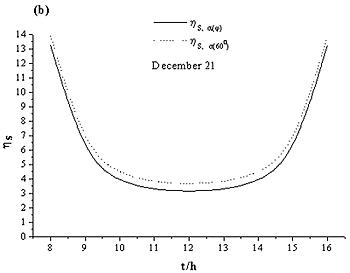
Experimental measurements of light intensity were made on a model, placed on a flat platform fully exposed to sun, which could simulate a classical greenhouse as well as all of the types of greenhouses (a) to (d). The results are shown in Figs.8 and 9 for two clear winter days in Belgrade, Yugoslavia (close to 44 ° NL). It is seen that they reproduce the calculated behaviour quite well, expect when scattered clouds appear at some hour of the day.
One should note that no account was made in the theory (and the calculations) of the contribution of the sky (diffuse) radiation. The agreement between the theoretical and experimental results indicates that in a clear day this contribution is small. The simulation is different for a partly of completely cloudy sky and its consideration will be the subject of another communication.
